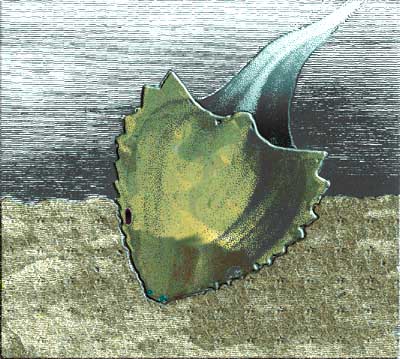
| Palaeos: |  |
Pteraspidomorphi |
| The Vertebrates | Amphiaspidida (2) |
| Page Back | Unit Home | Unit Dendrogram | Unit References | Taxon Index | Page Next |
| Unit Back | Vertebrates Home | Vertebrate Dendrograms | Vertebrate References | Glossary | Unit Next |
Abbreviated Dendrogram
Vertebrata |--Conodonta `--+--Thelodonti | Pteraspidomorphi |--Arandaspida `--Heterostracomorphi |--Astraspidae `--Heterostraci |--Cyathaspidiformes | |--Cyathaspidida | `--Amphiaspidida | |--Amphiaspidoidei | `--+--Hibernaspidoidei | `--Siberiaspidoidei `--Pteraspidiformes |--Pteraspididae `--Psammosteida |--Drepanaspis `--Psammosteidae |
Contents
Overview |
 Amphiaspidoidei: Amphiaspis,
Angraspis, Edaphaspis, Gabreyaspis, Kureykaspis, Olbiaspis, Pelaspis,
Prosarctaspis, Tareyaspis
Amphiaspidoidei: Amphiaspis,
Angraspis, Edaphaspis, Gabreyaspis, Kureykaspis, Olbiaspis, Pelaspis,
Prosarctaspis, Tareyaspis
Range: Early Devonian (Lochkovian to earliest Emsian) of Siberia [N86]
Phylogeny: Amphiaspidida:: (Hibernaspidoidei + Siberiaspidoidei) + *.
Characters: All plates fused, with occasional exception of the posterior ventral area [N86]; anterior margin rounded or straight [N86]; mouth ventral, terminal or subterminal [N86]; oral tubes absent [N86]; orbits at anterodorsal margin of the armor [N86]; praespiracular apertures are present adjacent to orbit [N86]; lateral edges smooth or with "teeth" [N86]; sensory line furrows usually short, slightly curved in the longitudinal lines frequently found? in the alar regions [N86]; sensory line system confined to pit lines, without channels [S64]; ventromedially, sensory lines ‘V’-shaped, with anterior commisures forming rectangular figure [N86]; commisures are positioned laterally relative to the longitudinal ventral lines [N86]; pattern of sensory lines unique [S64]; sculpturing present as flattened ridges with smooth edges (in older forms) [N86]; or with tubercles and grebeshkis [N86] [S64]; some species have tesserae [N86].
Note: Stensiö wrote when only three amphiaspids were known. His comments refer here only to Amphiaspis.
Image: Angaraspis from [N86].
References: Novitskaya (1986) [N86]; Stensiö (1964) [S64]. ATW030508.
 Hibernaspidoidei: Aphataspis,
Eglonaspis, Empedaspis, Gerronaspis, Hibernaspis, Lecanaspis, Pelurgaspis,
Putoranaspis
Hibernaspidoidei: Aphataspis,
Eglonaspis, Empedaspis, Gerronaspis, Hibernaspis, Lecanaspis, Pelurgaspis,
Putoranaspis
Range: Early Devonian (Pragian to Emsian) of Siberia [N86], including Lochkovian of Severnaya Zemlya [B+02].
Phylogeny: Amphiaspidida::: Siberiaspidoidei + *.
Characters: All plates are fused, with the occasional exception of the posterior ventral area [N86]; anterior margin usually extended as an oral tube (absent in primitive forms) [N86]; mouth ventral and subterminal, or terminal in forms having an oral tube [N86]; orbits on lateral margin of armor, or laterally on dorsal surface, or towards the distal end of an oral tube, or absent [N86]; praespiraculum absent [N86]; lateral edges with teeth (except Putoranaspis) [N86]; sensory sulci are present and, probably in some species, sensory channels (huh?) [N86]; supraorbital sensory line are not always present [N86]; longitudinal pairs of sulci (medial and lateral) form, with cross-commisures, rectangular figures [N86]; cross commisures usually lateral relative to ventral longitudinal furrows (??) [N86]; sculpturing looks like wide strips with smooth edges [N86]; some species with large, hexagonal tubercles [N86] [S64]; between strips are sometimes interspersed separate rounded tubercles [N86]; tesserae are absent [N86].
Note: Stensiö wrote when only three amphiaspids were known. His comments refer here only to Eglonaspis and Hibernaspis.
Image: Hibernaspis adapted from [N86]. Note that the large oval laterally is not an orbit, but the branchial opening. The orbits are two tiny dots on the dorsal surface of the rostrum.
Links: IX Capitolo - I Primi Pesci.
References: Blieck et al. (2002) [B+02]; Novitskaya (1986) [N86]; Stensiö (1964) [S64]. ATW040726.
Siberiaspidoidei: Argyraspis, Dotaspis, Litotaspis, Siberiaspis, Tuxeraspis.
Range: Early Devonian (Pragian) of Siberia.
Phylogeny: Amphiaspidida::: Hibernaspidoidei + *.
Characters: All plates of the shield are fused [N86]; anterior margin rounded, straight, or superficially excavated [N86]; oral tubes absent [N86]; mouth ventral, terminal or subterminal [N86]; orbits laterodorsal or on lateral edges of armor; [N86]; praespiracula absent [N86]; lateral edges, where known, without jagged projections [N86]; sensory line system present as sulci and channels (the last are definitively known in the Siberiaspididae) [N86]; arrangement of the sensory sulci as in Amphiaspidoidei; sculpturing present as smooth platens or tubercles with smooth or jagged edges (i.e. grebeshkis) [N86]; tesserae absent [N86].
References: Novitskaya (1986) [N86]. ATW030509.
| Page Back | Unit Home | Page Top | Page Next |
checked ATW060104